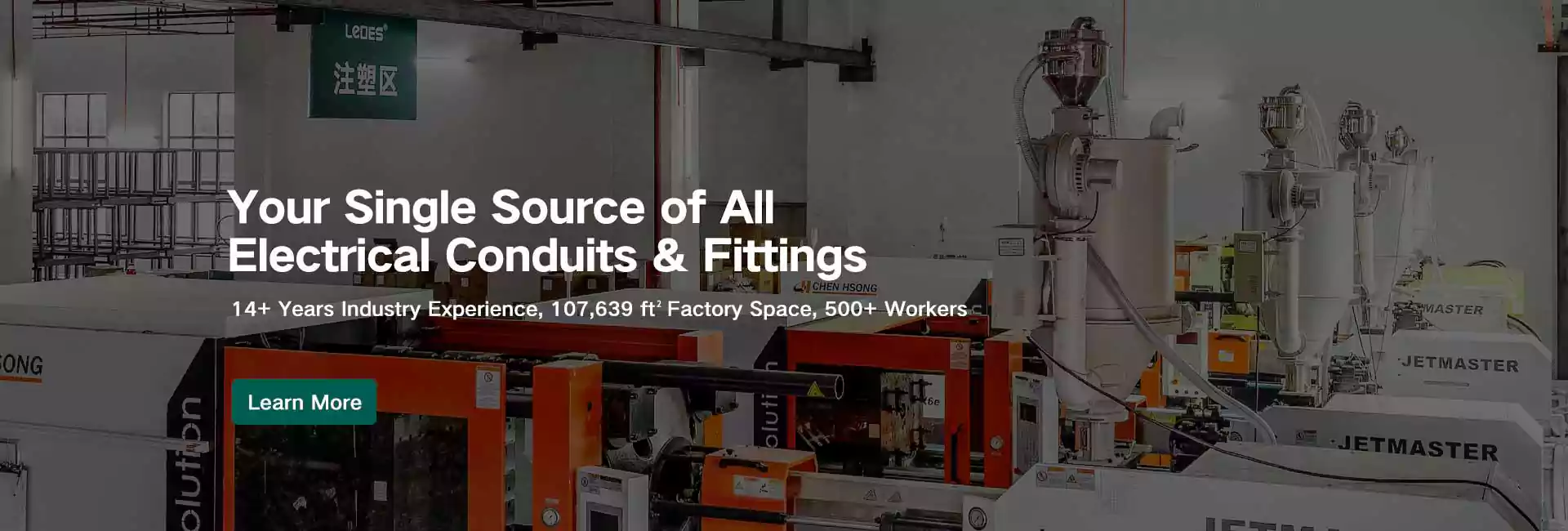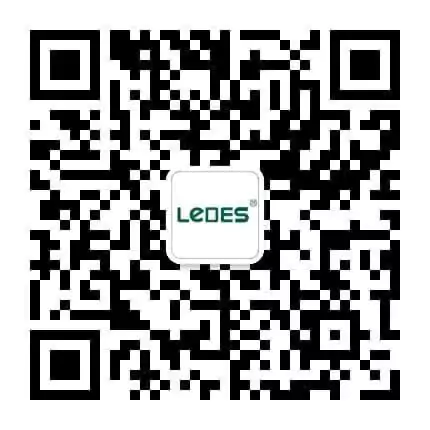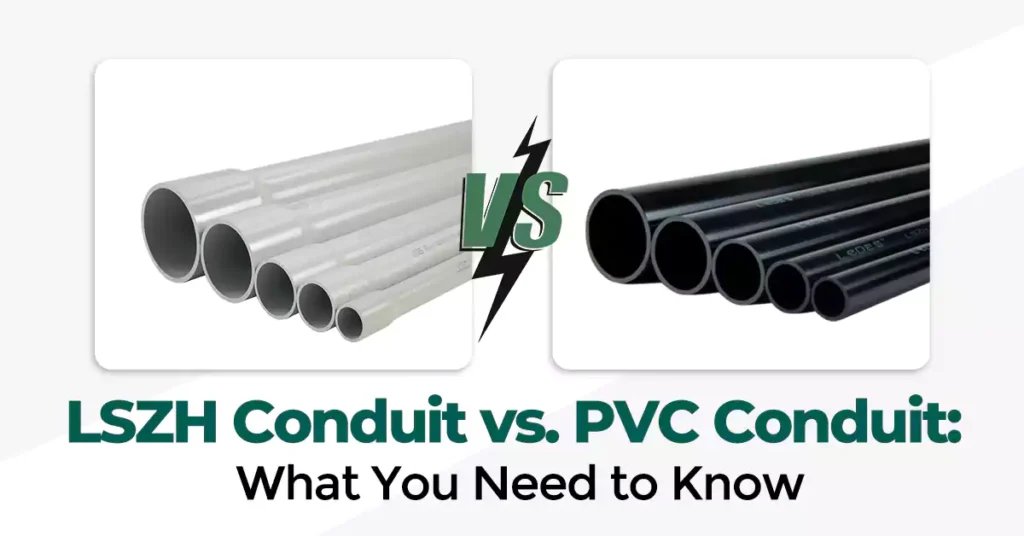
目录
When it comes to electrical installations, choosing the right type of conduit is crucial for ensuring safety, durability, and compliance with industry standards. Among the most commonly used options are LSZH – Low Smoke Zero Halogen conduit and PVC – Polyvinyl Chloride conduit. While both serve the purpose of protecting electrical wiring, they have distinct properties that make them suitable for different applications.
LSZH conduit is designed to minimize the release of toxic gases and smoke in case of fire, making it an ideal choice for enclosed or high-risk environments such as tunnels, public buildings, and transportation infrastructure. On the other hand, PVC conduit is widely used due to its affordability, corrosion resistance, and ease of installation, making it a go-to option for residential, commercial, and industrial electrical systems.
Why Is This Comparison Important?
Electrical conduit selection directly impacts safety, environmental sustainability, and long-term system reliability. Factors such as fire resistance, mechanical strength, chemical resistance, and regulatory compliance must be considered when choosing between LSZH and PVC conduit.
What You Will Learn
In this article, we will explore:
- The key differences between LSZH conduit and PVC conduit pipe
- The advantages and disadvantages of each type
- Their suitability for various applications
- Compliance with safety and environmental standards
- Practical considerations when selecting the right conduit for your project
By the end of this guide, you’ll have a clear understanding of which conduit type best meets your needs, whether you prioritize fire safety, cost-effectiveness, or durability.
What is LSZH Conduit?
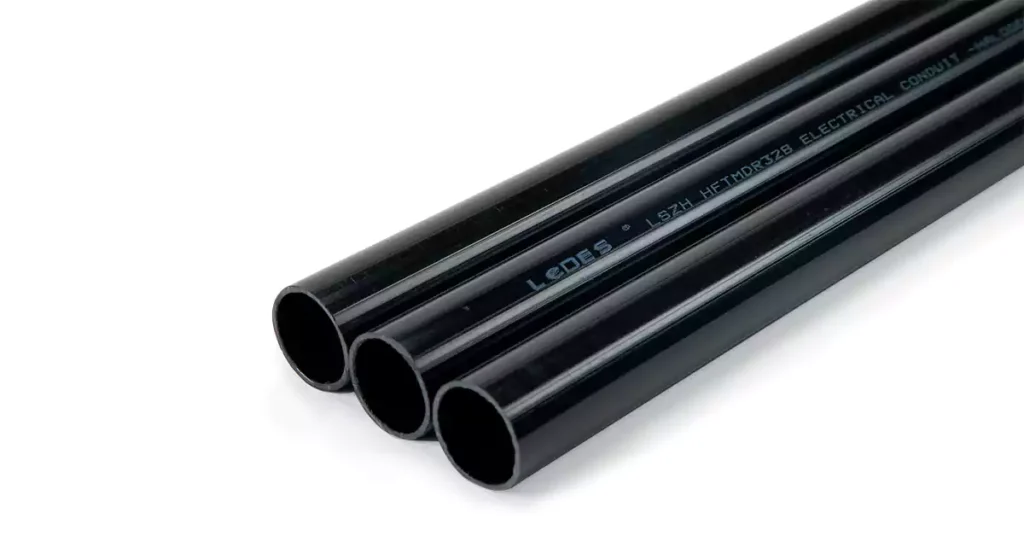
定义
Low Smoke Zero Halogen (LSZH) conduit is a type of plastic electrical conduit made from materials that do not contain halogens, such as chlorine, fluorine, bromine, or iodine. Unlike traditional PVC conduit, which can release harmful gases when burned, LSZH conduit is designed to emit minimal smoke and no toxic halogen gases in the event of a fire.
This makes LSZH conduit a preferred choice for applications where fire safety and air quality are critical, such as in enclosed spaces, public buildings, tunnels, and data centers.
Key Features & Benefits of LSZH Conduit
Low Smoke Emission During Fire
Produces significantly less smoke compared to traditional PVC conduit.
Enhances visibility during fire incidents, aiding safe evacuation.
Reduces smoke-related damage to sensitive electronic equipment.
No Toxic Halogen Gases
Free from chlorine, fluorine, bromine, and other harmful halogens.
Prevents the formation of corrosive and highly toxic gases that can harm people and damage equipment.
Suitable for enclosed spaces where maintaining air quality is crucial.
Enhanced Fire Resistance
Many LSZH conduits are designed to have self-extinguishing properties, preventing flame propagation.
Reduces the risk of fire spreading through electrical systems.
Ideal for Enclosed or Populated Spaces
Commonly used in tunnels, hospitals, airports, data centers, commercial buildings, and transportation systems.
Helps meet stringent fire safety regulations and environmental standards in public infrastructure.
Essential for locations with high occupancy or limited ventilation.
Eco-Friendly and Sustainable
LSZH conduit is more environmentally friendly than PVC as it does not release hazardous substances into the air.
Preferred in projects with a focus on green building certifications and sustainability.
什么是 PVC 导管?
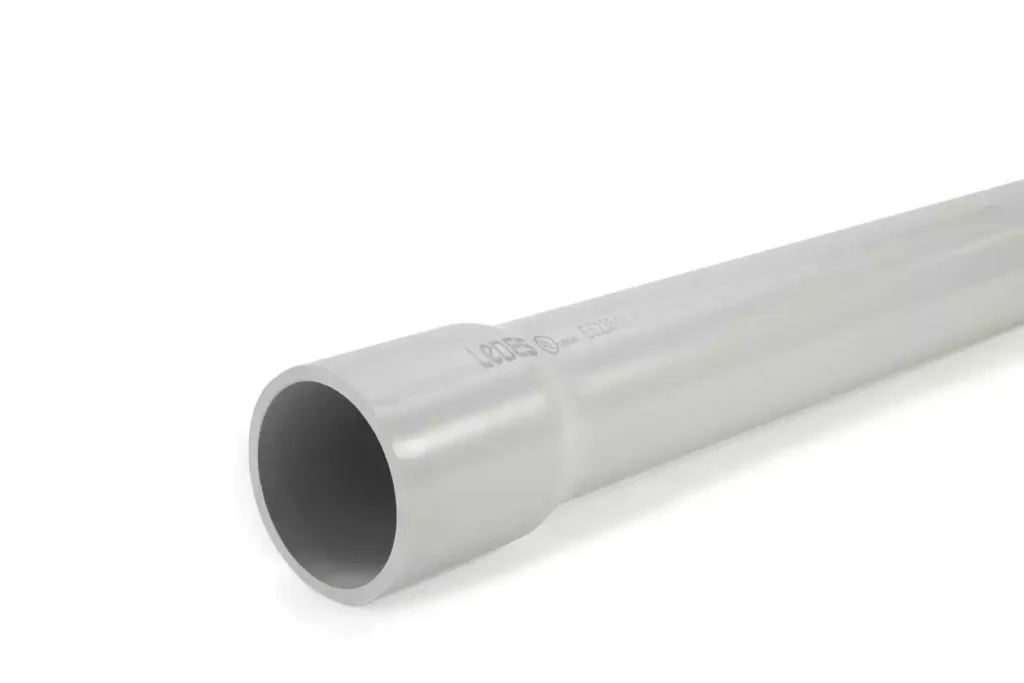
定义
Polyvinyl Chloride (PVC) conduit is one of the most widely used electrical conduit types, known for its affordability, durability, and ease of installation. Made from rigid PVC material, this conduit offers excellent insulation, moisture resistance, and corrosion resistance, making it suitable for various electrical applications in residential, commercial, and industrial settings.
PVC conduit is available in different thicknesses and classifications, such as Schedule 40 and Schedule 80, as well as specialized types like DB2 for underground installations. It is commonly used to protect electrical wiring from mechanical damage, environmental factors, and chemical exposure.
Key Benefits of PVC Conduit
Cost-Effective and Widely Available
One of the most affordable conduit options compared to metal and LSZH conduit.
Readily available in different sizes and types, making it easy to source for various applications.
Lower material and labor costs contribute to cost-effective electrical installations.
Durable and Weather-Resistant
Resistant to corrosion, rust, and chemical degradation, making it ideal for wet and corrosive environments.
UV-resistant options are available for outdoor installations exposed to sunlight.
Can withstand various environmental conditions, from underground burial to above-ground use.
Easy to Install
Lightweight compared to metal conduit, reducing handling and labor costs.
Can be easily cut, shaped, and joined using solvent cement or threaded fittings.
Requires minimal specialized tools for installation.
Electrical Insulation and Safety
Non-conductive material eliminates the risk of electrical shocks and grounding issues.
Fire-resistant versions are available, though standard PVC conduit can emit toxic fumes when burned.
Versatile Applications
Used in residential, commercial, and industrial electrical systems.
Suitable for above-ground and underground installations, including direct burial and concrete encasement.
Commonly used for solar installations, telecommunications, and HVAC systems.
Key Differences: LSZH vs. PVC Conduit
When choosing between LSZH (Low Smoke Zero Halogen) conduit and PVC (Polyvinyl Chloride) conduit, it’s essential to understand their fundamental differences. These materials differ in terms of composition, safety, fire performance, code compliance, installations, and cost etc, which influence their suitability for various applications.
Pro tips: You can read our last post for the LSZH conduit beginner guide first if you are finding it difficult to understand as follow content.
Material Composition & Safety
LSZH Conduit:
LSZH conduit is made from special thermoplastic or thermoset compounds that do not contain halogens such as chlorine, fluorine, bromine, or iodine. The primary goal of LSZH materials is to minimize toxic emissions and prevent corrosive gas formation when exposed to fire.
LSZH materials are engineered using alternative flame-retardant additives such as:
- Aluminum hydroxide (Al(OH)₃) – releases water vapor when heated, which helps suppress flames.
- Magnesium hydroxide (Mg(OH)₂) – provides heat absorption and further reduces smoke production.
- Phosphorus-based compounds – enhance fire resistance while maintaining mechanical flexibility.
These materials do not produce corrosive fumes when burned, making LSZH conduit a safer choice in enclosed spaces, transportation hubs, and critical infrastructure where air quality is a priority.
PVC 导管:
PVC conduit is made from polyvinyl chloride, a synthetic plastic polymer that contains chlorine. While PVC is inherently flame-resistant due to its self-extinguishing properties, it releases toxic halogen gases such as hydrogen chloride (HCl) when burned.
These gases pose serious health risks, as they can cause severe respiratory irritation and contribute to acidic corrosion when mixed with water. This is a significant concern in sensitive environments like data centers, hospitals, and tunnels, where equipment and human safety are paramount.
Fire & Smoke Performance
LSZH Conduit: Superior Fire Safety
- Minimal smoke production – Improves visibility for safe evacuation.
- No toxic halogen gases – Reduces health hazards and prevents damage to electronic equipment.
- Does not produce corrosive acid gases – Prevents long-term structural damage to infrastructure.
- Complies with fire safety standards such as IEC 60754, IEC 61386, and UL 94.
Because of these properties, LSZH conduit is often required in high-risk areas such as subway systems, airports, marine vessels, and telecom facilities where fire hazards must be minimized.
PVC Conduit: Moderate Fire Resistance but High Smoke & Toxicity Risks
- Naturally flame-retardant – Can self-extinguish when the heat source is removed.
- Releases dense smoke and toxic gases – Increases risks of suffocation and visibility issues.
- Hydrogen chloride emissions – Forms hydrochloric acid when exposed to moisture, leading to severe damage to metal and electrical systems.
- Complies with standards like UL 651 and NEC requirements for general use, but not ideal for critical fire-sensitive applications.
While PVC conduit is acceptable for many electrical installations, it may not be suitable for locations where fire safety, air quality, and human exposure risks are key concerns.
守则合规性
Compliance with industry standards is essential to ensure safety, durability, and performance. Both LSZH and PVC conduits must meet specific regulatory requirements to be used in various electrical installations.
LSZH Conduit
LSZH conduits are primarily regulated under the IEC 61386 standard, which specifies mechanical and electrical performance requirements for conduit systems. With IEC 61386-1 serving as the general performance benchmark, while IEC 61386-21 specifically for rigid conduit and IEC 61386-23 for corrugated conduit.
IEC 61386-1: General Requirements
Under IEC 61386, conduits are classified based on different performance levels, which are indicated by a series of two-digit numbers in the standard.
Notes: As to the IEC 61386 standard for electrical conduit, we wrote a post before to explain more details; you can read our last post.
The classification considers:
- By Mechanical Strength (e.g. compression, impact, tensile strength load capacity):
Very light, Light, Medium, Heavy, Very heavy.
- By Flexibility: Rigid and flexible conduit.
- By Flammability: Non-flame propagating and flame propagating.
And other factors such as the ability to withstand low and high temperatures, electrical characteristics, waterproofing, and resistance to corrosion etc.
性能要求:
IEC 61386-1 specifies a range of mechanical, electrical, and environmental tests that LSZH conduits must pass to ensure reliability in electrical installations. Key tests include:
Compression Strength Test:
Measures how much force the conduit can withstand before deforming or failing under pressure.
It involves different forces for different class of conduit:
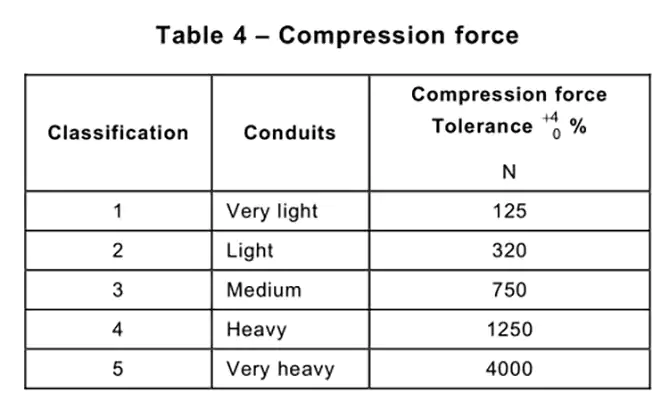
Impact Resistance Test:
Evaluates the conduit’s ability to absorb mechanical shocks, including tests at low temperatures to ensure resilience in cold environments. And the applied impact mass and height are as shown in the table:
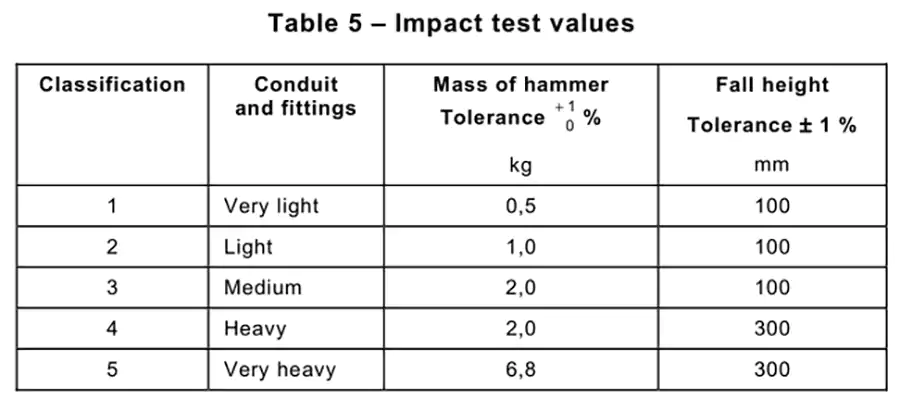
抗拉强度:
Measures the conduit’s resistance to pulling forces, ensuring it remains intact during cable pulling. A tensile force (pulling force) is applied at a controlled speed until the conduit breaks or elongates beyond acceptable limits.
Pro Tips: We explain details about impact resistance and tensile strength in the last post; you can read it if you have an interest in this part.
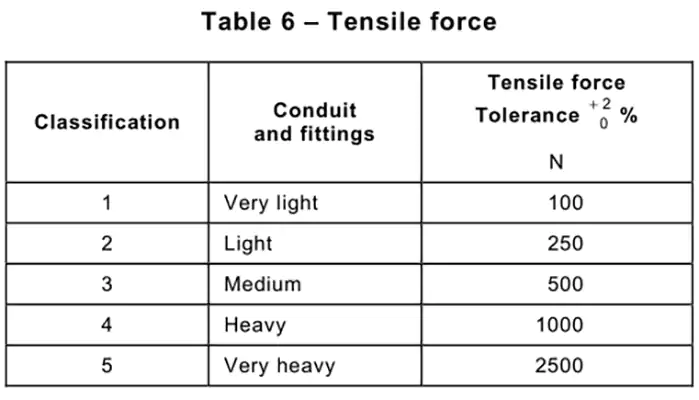
Electrical Insulation Resistance:
Ensures the conduit provides high electrical resistance to prevent short circuits.
A high voltage (e.g., 1000V to 2000V) is applied between the inner and outer conduit surface.
The conduit must not conduct current or allow leakage.
Fire Performance Test:
Evaluates the conduit’s reaction to fire, do not propagate flames.
Pro Tips: As to measure fire resistance performance, as we discussed in the last post, you can read it if you are interested in this part.
- Glow-Wire Test (IEC 60695-2-11):
A 750°C glow wire is applied to the conduit in a vertical position.
The conduit passes if there is no visible flame, or if flames self-extinguish within 30 seconds.
- kW Flame Test (IEC 60695-11-2):
A 675 mm conduit sample is mounted vertically and exposed to a 1 kW flame at a 45° angle.
The test ensures that flames self-extinguish within 30 seconds and do not ignite tissue paper placed below.
IEC 61386-21: Particular Requirements - Rigid Conduit Systems
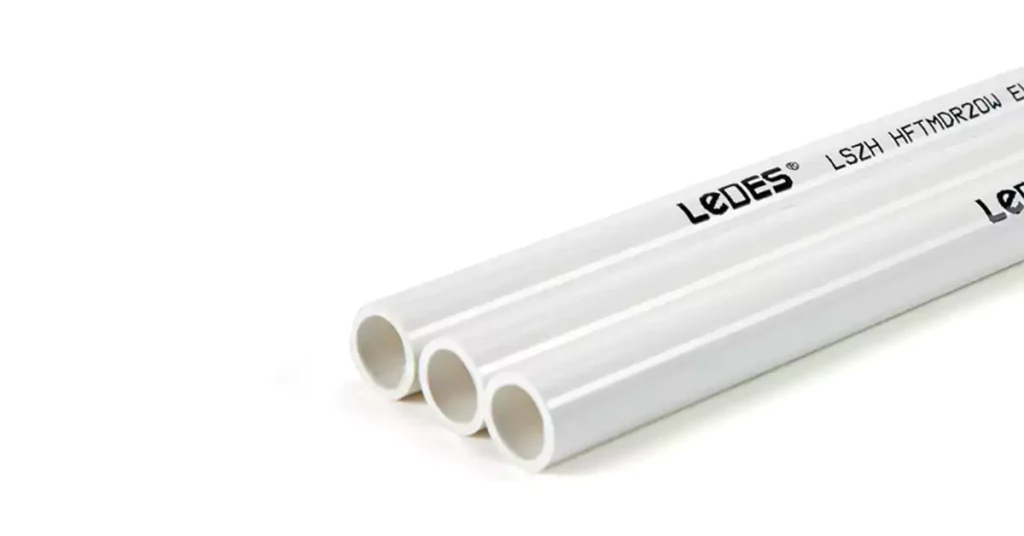
It involves performance for rigid conduits, including metallic and non-metallic conduits.
Key Test Include:
Compression Test: Refer to the test in the IEC 61386-1.
弯曲测试:
Determines flexibility and resistance to cracking.
For non-metallic conduits, sizes 16, 20 and 25 and composite conduits are tested to a bending apparatus, and after test, the conduit should show no cracks visible and should be possible to pass the appropriate gauge.
坍塌测试:
The collapse test evaluates the mechanical stability of non-metallic and composite conduits, particularly those that are bendable. This test ensures that the conduit maintains its internal passage after exposure to heat, preventing blockages that could interfere with electrical installations.
The conduit is bent according to standard bending requirements without the use of bending aids. And then fixed onto a rigid support using four straps. Exposing the conduit in a heating cabinet for 24 hours.
- After heating, the support is positioned so that the conduit forms a 45° angle to the vertical, with one end pointing upwards and the other downwards.
- A standardized gauge is inserted at the upper end and must pass through the conduit under its own weight without any initial force.
This test ensures that LSZH conduits maintain their internal integrity under high-temperature conditions.
Tensile Test: As described in the IEC 61386-1.
Fire Performance: As described in the IEC 61386-1.
IEC 61386-23: Particular Requirements - Flexible Conduit Systems
This standard is specially for flexible conduits. Combing with IEC part 1 to set requirements for conduits.
Mechanical Requirements Include:
Compression Test: As described in the IEC 61386-1.
弯曲测试:
The flexing test evaluates the mechanical durability and flexibility of LSZH conduits under repeated bending motions. This test ensures that the conduit and its fittings can withstand mechanical stress during installation and operation without cracking or losing their internal passage.
- The conduit is fixed to an oscillating apparatus that moves it back and forth through a 180° angle around a vertical axis.
- The assembly undergoes 5,000 flexing cycles at a rate of 40 ± 5 flexings per minute in a sinusoidal motion.
- After testing, the conduit must show no visible cracks under normal vision.
- A standard gauge must be able to pass through the conduit under its own weight without additional force.
Tensile Strength, Fire Performance: Refer to IEC 61386-1.
EN 50267-2: Determination of Acidity of Gases by Measuring pH and Conductivity
EN 50267-2 is a European standard that specifies the method for determining the acidity and corrosiveness of gases released during the combustion of non-metallic materials, such as LSZH (Low Smoke Zero Halogen) conduits. The standard evaluates whether the materials produce low-acidic and non-corrosive emissions, ensuring their suitability for fire-sensitive applications like data centers, tunnels, and transport systems.
Test Method and Procedure:
General Principle
A predetermined amount of the test material is burned in a tube furnace under controlled conditions. The gases released during combustion are captured and dissolved in distilled or demineralized water, and their acidity (pH) and conductivity are measured.
The water used for gas absorption must have the following properties:
- pH: 6.5 ± 1.0
- Conductivity: ≤ 0.5 µS/mm
These strict requirements ensure the accuracy of the test.
测试方法
Combustion Process
A 1,000 mg sample of the material is burned in a tube furnace at 935°C under controlled airflow.
The gases released are collected in distilled or demineralized water.
Measurement of Acidity and Conductivity
The pH level of the solution is measured to determine acidity.
The conductivity is measured to assess the corrosive potential of the gas.
Pass/Fail Criteria
The material passes if the pH remains above a specified limit (≥4.3) and conductivity stays within the allowed range.
If one sample fails, additional tests are conducted to confirm results.
This test ensures LSZH conduits meet fire safety requirements by minimizing harmful acidic gas emissions, reducing risks to people and equipment.
IEC 60754-1: Determination of the Halogen Acid Gas Content
IEC 60754-1 specifies the method for determining the amount of halogen acid gases released during the combustion of non-metallic materials, such as insulation and sheathing of electrical cables. This test is essential for assessing the potential corrosiveness and toxicity of materials in fire conditions.
Test Method Summary
- Combustion Process
- A test specimen is placed in a quartz glass tube and heated in a tube furnace at 800 ± 10°C under controlled airflow.
- The gases released during combustion are collected in a water solution.
- Halogen Acid Content Determination
- A blank test is conducted first for reference.
- The collected solution is treated with specific reagents and titrated using ammonium thiocyanate to determine the halogen acid content.
- The amount of acid is calculated in mg of hydrochloric acid per gram of test material.
- Evaluation Criteria
If the halogen acid content is ≤ 5 mg/g, the material is considered low in halogen acids, making it safer for use in sensitive environments.
This standard helps ensure materials used in electrical and communication cables produce minimal corrosive and toxic emissions, improving fire safety in buildings, tunnels, and public spaces.
IEC 60754-2: Determination of Acidity (pH Measurement) and Conductivity in Combustion Gases
IEC 60754-2 specifies the method for determining the acidity (pH) and conductivity of gases released during the combustion of non-metallic materials used in electrical and optical fiber cables. This test assesses the potential corrosiveness and environmental impact of materials in fire conditions.
Test Procedure Overview
Combustion Process
- The specimen is placed in a quartz glass tube and heated in a tube furnace at 935 ± 30°C under controlled airflow.
- Gases released during combustion are carried by the airflow and collected in a water solution over 30 ± 1 minutes.
Solution Preparation and Measurement
- The collected solution, including any residue from the apparatus, is diluted to 1,000 ml for analysis.
- The pH value is measured using a calibrated pH meter, and conductivity is determined using a conductivity meter, both at 25 ± 1°C.
Evaluation of Results
- The mean pH and conductivity values are calculated from multiple tests.
- If variability is too high (>5%), additional tests are required.
- Weighted pH and conductivity values can be estimated based on the composition of materials in a complete cable.
Performance Criteria
Acceptable pH and conductivity values should comply with individual cable standards or recommended limits in Annex A in the standard.
IEC 61034-2: Measurement of Smoke Density of Cables Burning Under Defined Conditions
IEC 61034-2 specifies the method for measuring the smoke density generated when cables burn under controlled conditions. This standard is particularly important for Low Smoke Zero Halogen (LSZH) conduits, ensuring that they emit minimal smoke in case of a fire, thereby improving visibility for evacuation and reducing smoke-related hazards.
The test involves placing the test sample horizontally 150 mm above an alcohol tray, which serves as the fire source. Before ignition, the test enclosure is conditioned to 25°C ± 5°C, and a blank test may be performed. The alcohol is ignited, and the smoke generated is measured by light transmittance over a test duration of up to 40 minutes. The minimum light transmittance is recorded, with a higher percentage indicating better performance.
To comply with IEC 61034-2, LSZH conduits must maintain a minimum light transmittance threshold, typically above 60%, reducing visibility obstruction in fire scenarios. After testing, the combustion products are extracted, ensuring accuracy in subsequent tests.
ASTM E662-17a: Standard Test Method for Specific Optical Density of Smoke Generated by Solid Materials
ASTM E662-17a is a standard test method used to measure the specific optical density of smoke produced by solid materials, such as plastics, cables, and conduits, under controlled fire conditions. This test is important for Low Smoke Zero Halogen (LSZH) conduits, as it assesses their smoke production levels and helps determine their suitability for fire-sensitive environments like tunnels, data centers, and public buildings.
Test Method Summary
- Test Chamber and Sample Placement
The test is conducted in a closed chamber (smoke density chamber) with a light beam and photodetector to measure smoke density.
A sample of the test material is placed on a holder inside the chamber.
- Combustion Process
The sample is exposed to a heat source in either:
Flaming Mode: Direct exposure to a flame.
Non-Flaming Mode: Exposure to radiant heat without direct ignition.
- Smoke Density Measurement
The specific optical density (Ds) is calculated based on how much light is blocked by smoke inside the chamber.
The maximum specific optical density (Ds max) is recorded.
- Performance Criteria
Materials with lower Ds max values are considered better in terms of low smoke emission.
LSZH materials must have a Ds max within acceptable limits to be used in safety-critical applications.
ASTM E662-17a ensures that LSZH conduits produce minimal smoke, improving fire safety and visibility in emergency situations. It is widely used alongside IEC 61034-2 for evaluating the smoke performance of electrical materials.
ISO 4589-2: Plastics – Determination of Burning Behaviour by Oxygen Index
ISO 4589-2 specifies a method for determining the minimum concentration of oxygen required to support the combustion of plastic materials under ambient temperature conditions. This is known as the Limiting Oxygen Index (LOI) and is expressed as a percentage. The higher the LOI, the greater the material’s resistance to burning in normal atmospheric conditions.
This test is essential for evaluating the fire resistance of LSZH conduits and other plastic materials used in electrical and construction applications. Materials with a higher LOI are more flame-retardant and offer improved fire safety performance.
ISO 19700: Controlled Equivalence Ratio Method for the Determination of Hazardous Components of Fire Effluents
ISO 19700 defines a standardized method for assessing the hazardous components of fire effluents. It focuses on measuring the toxic gases released during material combustion under controlled fire conditions. The method helps evaluate the potential risks of materials used in various applications, including electrical conduits, ensuring fire safety compliance.
Test Method Summary
Test Apparatus: A steady-state tube furnace is used to simulate different fire conditions by varying the equivalence ratio (the ratio of fuel to available oxygen).
测试程序:
- The test material is placed in the tube furnace, where it undergoes controlled burning.
- The fire conditions range from well-ventilated to under-ventilated, replicating real-life fire scenarios.
- The combustion gases are collected and analyzed for toxic components such as carbon monoxide (CO), carbon dioxide (CO₂), hydrogen cyanide (HCN), hydrogen chloride (HCl), and other hazardous species.
Results Evaluation: The measured gas concentrations help determine fire toxicity, allowing material classification based on its fire hazard potential.
ISO 19700 is essential for evaluating low-smoke, halogen-free (LSZH) materials, ensuring they release minimal toxic gases in case of fire, making them safer for enclosed environments like buildings and transportation systems.
UL 94 Tests for Flammability of Plastic Materials
UL 94 is a widely recognized flammability standard that evaluates the burning behavior of plastic materials used in electrical and electronic applications. This standard is crucial for assessing the fire safety performance of Low Smoke Zero Halogen (LSZH) conduit, ensuring it meets stringent fire resistance requirements while minimizing toxic emissions in case of fire.
目的
The primary goal of UL 94 is to classify plastics based on their burning behavior, offering insights into their suitability for various applications where fire resistance is essential.
Ratings and Requirements
L 94 classifies plastics into several categories, each with specific criteria:
- HB (Horizontal Burning):
Test Method: A specimen is positioned horizontally and exposed to a flame for 30 seconds or until the flame reaches a specified mark. The burn rate is then measured.
标准: For materials 3 to 13 mm thick, the burn rate must not exceed 40 mm per minute; for those less than 3 mm thick, it must not exceed 75 mm per minute.
等级: HB indicates slow burning on a horizontal specimen.
- Vertical Burning (V-0, V-1, V-2):
Test Method: A vertically oriented specimen undergoes two 10-second flame applications. After each application, after flame and afterglow times are recorded, along with observations of dripping particles.
标准:
V-0: Flame extinguishes within 10 seconds; no flaming drips allowed.
V-1: Flame extinguishes within 30 seconds; no flaming drips allowed.
V-2: Flame extinguishes within 30 seconds; flaming drips are permitted.
- Vertical Burning, Severe Test:
Test Method: Specimens are subjected to five 5-second flame applications with a more severe ignition source.
标准:
5VA: Flame extinguishes within 60 seconds; no burn-through (no hole) in the specimen.
5VB: Flame extinguishes within 60 seconds; burn-through (hole) is allowed.
These classifications assist manufacturers in choosing suitable plastic materials to ensure compliance with safety standards and regulatory requirements.
等级 | Orientation | Flame Application | Requirements | Dripping Allowed? | Burn-Through Allowed? |
HB | Horizontal | Burning rate of less than 76mm/min for a specimen less than 3mm thick and burning stops before 100mm | |||
V-2 | Vertical | 30 seconds | Burning stops within 30 sec; flaming drips allowed | 是的 | No |
V-1 | Vertical | 30 seconds | Burning stops within 30 sec; drips of particles allowed as long as they are not inflamed. | No | No |
V-0 | Vertical | 10 seconds | Burning stops within 10 sec; drips of particles allowed as long as they are not inflamed. | No | No |
5VB | Vertical | 60 seconds | Burning stops within 60 sec; no flaming drips; holes allowed | No | 是的 |
5VA | Vertical | 60 seconds | Burning stops within 60 sec; no flaming drips; no holes | No | No |
Ledes LSZH Conduit: Committed to Fire Safety
Ledes’ LSZH 导管 are engineered with a focus on superior fire safety. Achieving UL 94 V-0 and 5VA ratings, they ensure:
V-0 Rating: Rapid self-extinguishment within 10 seconds without flaming drips, suitable for applications requiring high flame resistance.
5VA Rating: Exceptional performance under severe flame conditions, with no burn-through, making them ideal for critical safety applications.
These attributes make Ledes LSZH conduits a reliable choice for environments where fire safety and minimal smoke emission are paramount.
UL 1685: Vertical-Tray Fire-Propagation and Smoke-Release Test for Electrical and Optical-Fiber Cables
UL 1685 is a standard developed to evaluate the flame propagation and smoke release characteristics of electrical and optical-fiber cables when exposed to fire conditions. This standard incorporates two primary test methods: the UL Flame Exposure Test and the FT4/IEEE 1202 Type of Flame Exposure Test.
▲ Flame Exposure Test
The UL 1685 Flame Exposure Test evaluates the fire performance of electrical cables by assessing flame spread and smoke production.
Test Setup
A propane-gas burner with a flat metal plate and 242 small holes creates a controlled flame.
The burner is positioned 3 inches (76 mm) from the cable tray, with the flame centered between two tray rungs.
Flowmeters monitor propane and air supply, ensuring accurate gas flow.
测试程序
- 准备: The cables, test area, and equipment are set to a minimum temperature of 41°F (5°C).
- 火焰应用:
The burner ignites, and gas flows are adjusted.
The flame is applied continuously for 20 minutes.
- 观察:
The flame height and burning duration are recorded.
Once the burner is turned off, any remaining fire is allowed to self-extinguish.
- Damage Assessment:
Cables are cleaned, and char height is measured.
Additional damage like melting is also recorded.
Smoke Measurement
- A photometer system tracks smoke levels in the exhaust duct.
- The Smoke Release Rate (SRR) and total smoke released over 20 minutes are calculated.
验收标准
To pass the UL 1685 test, the cable must meet the following limits:
Char height: Less than 8 feet (244 cm).
Total smoke released: No more than 95 m².
Peak smoke release rate: No more than 0.25 m²/s.
▲ FT4/IEEE 1202 Flame Exposure Test
The FT4/IEEE 1202 Flame Exposure Test is a vertical-tray fire test used to evaluate the flame propagation and smoke release characteristics of electrical and optical-fiber cables. It helps determine whether cables meet fire safety requirements, particularly for limited smoke marking applications.
Test Method Summary
- Test Setup
- The test specimen is placed in a vertical cable tray inside an enclosure with proper ventilation.
- A propane-gas ribbon burner with a 242-hole flame array is used as the ignition source.
- The burner is positioned at a 20° angle, 12 inches (305 mm) above the tray base, and 3 inches (75 mm) from the cable surface.
- Flame Application
- The burner is ignited, and the flame is applied continuously for 20 minutes.
- Gas flow is controlled to 28 ±1 standard cubic feet per hour for propane and 163 ±10 standard cubic feet per hour for air.
- Smoke and Damage Evaluation
- A photometer system measures smoke density in the exhaust duct.
- After the test, the char height and other visible damage on the cables are measured.
- 验收标准
- Char height must be less than 4 ft, 11 inches (1.5 m) from the lower edge of the burner.
- Total smoke released must not exceed 150 m² in 20 minutes.
- Peak smoke release rate must not exceed 0.40 m²/s.
The FT4/IEEE 1202 test ensures that cables used in buildings, tunnels, and industrial environments have controlled flame spread and low smoke emission, improving overall fire safety.
Similarities and Differences Between These Two Flame Exposure Tests
Similarities:
- 目的: Both tests evaluate the flame resistance of electrical cables and conduits under standardized fire conditions.
- 测试设置: Cables and conduits are mounted in a vertical steel ladder tray, which is 12 inches wide, 3 inches deep, and 96 inches long, with 1-inch rungs spaced 9 inches apart.
- Flame Applications: A ribbon burner using a propane-air mixture applies flame for 20 minutes at a power output of 70,000 Btu/hr.
- Burning Duration: A cable may continue burning after the flame is removed, but the test is not complete until the cable stops burning.
- Smoke Test (Optional): Both tests include an optional smoke measurement where smoke release is evaluated using a photometer system.
方面 | UL Flame Exposure Test | FT4/IEEE 1202 Flame Exposure Test |
Standard Reference | UL 1685 (General Method) | UL 1685 (FT4/IEEE 1202 Method) |
Primary Application | Used for U.S. cable and conduit compliance | Required for Canada (FT4-rated cables and conduits) and some U.S. markets |
Burner Position | Horizontally placed, 3 inches from the cable surface, 18 inches from the bottom of the tray | Angled at 20°, 3 inches from the surface of the tray, and 12 inches from the bottom of the tray |
Pass/Fail Criteria | Char height must be less than 8 feet (244 cm) | Char height must be less than 4 feet, 11 inches (1.5 m) (More stringent requirement) |
Total Smoke Released (Optional Test) | Must not exceed 95 m² | Must not exceed 150 m² |
Peak Smoke Release Rate (Optional Test) | Must not exceed 0.25 m²/s | Must not exceed 0.40 m²/s |
Both tests ensure that electrical cables meet fire safety standards and help minimize risks in buildings, tunnels, and public spaces.
NFPA 130: Standard for Fixed Guideway Transit and Passenger Rail Systems
NFPA 130 is a National Fire Protection Association standard that establishes fire protection and life safety requirements for various components of rail transit systems, including stations, trainways, vehicles, and related infrastructure. Its primary objective is to ensure a reasonable degree of safety for passengers and personnel in the event of a fire.
NFPA 130 includes specific fire performance requirements for electrical components, including conduits and cables, to limit fire spread and reduce smoke generation in enclosed transit environments. LSZH (Low Smoke Zero Halogen) conduits are commonly used in these applications due to their fire-resistant properties and low toxicity during combustion.
Here are some key requirements to LSZH conduit:
Flame Spread and Smoke Emission: Electrical cables and conduits used in transit systems must pass strict flame propagation and smoke release tests, such as the FT4/IEEE 1202 flame test and UL 1685 smoke release test, to ensure minimal fire spread and reduced smoke hazards.
Durability in Harsh Environments: NFPA 130 requires electrical systems to withstand high temperatures and moisture exposure, ensuring safety in both normal and emergency conditions. LSZH conduits, known for their high heat resistance and non-corrosive properties, help meet these durability standards.
Material Considerations: While NFPA 130 does not specifically mandate LSZH materials, it emphasizes the need for non-combustible and low-smoke-emitting components. LSZH conduits align with these criteria by eliminating halogens and reducing toxic gas emissions, which improves visibility and minimizes health risks during fire events.
NFPA 130 serves as a critical guideline for fire safety in transit infrastructure, requiring electrical components to meet stringent fire performance criteria. While LSZH conduit is not explicitly required, its low-smoke and halogen-free properties make it a preferred choice in compliance with NFPA 130’s fire safety objectives.
PVC 导管
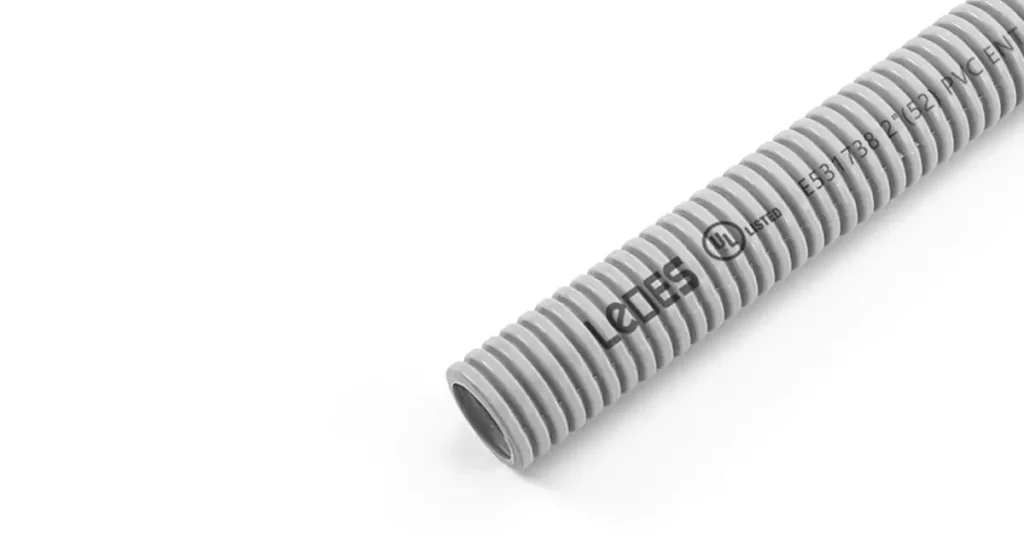
When it comes to electrical installations, it is crucial that PVC conduits meet stringent standards to ensure safety, durability, and performance. These standards are set by various organizations across the globe, each with its own set of regulations to govern PVC conduit performance in different environmental conditions. Below, we’ll summarize the key codes for PVC conduits in America, Canada, and Australia.
美国
- UL651: This standard covers Schedule 40 and 80 Rigid PVC Conduit for use in electrical wiring. It specifies requirements for strength, flame resistance, and other physical properties to ensure safety in installations.
- UL 1653: This standard applies to Electrical Nonmetallic Tubing (ENT), not rigid PVC conduit. It specifies construction and performance requirements for ENT systems used in electrical installations.
Notes: If you would like to learn more about UL 651 standards for rigid PVC conduit 和 UL 1653 standards for ENT tubing,您可以阅读我们的上一篇文章。
加拿大
- CSA C22.2 No.211.2: This standard is for Rigid PVC Conduit. It sets the guidelines for the construction, performance, and testing requirements of PVC conduit used for electrical installations in Canada.
- CSA C22.2 No.211.1: This standard applies to EB1, DB2/ES2 PVC Conduit. It defines the material and performance characteristics for these specific PVC conduit types, ensuring they meet fire, mechanical, and weather resistance requirements.
Pro Tips: Learn more about CSA standard requirements for Rigid conduit in our last post.
澳大利亚
- AS/NZS 2053.1: This is the General Requirements Standard for PVC conduit and fittings in Australia and New Zealand. It outlines the overall specifications for materials, dimensions, and installation guidelines.
- AS/NZS 2053.2: This standard addresses Rigid Plain Conduits and Fittings, focusing on their construction, performance, and testing requirements for electrical installations.
- AS/NZS 2053.5: This standard applies to Corrugated Conduits and Fittings and covers the specifications for flexible PVC conduit used in electrical installations, ensuring durability and safety
For more detailed information about these codes, refer to our previous articles where we explore the standards for PVC conduits in depth.
Notes: Want to learn more about AS/NZS 2053 standard? Click here to read the Ultimate Guide to AS/NZS 2053.
Electrical Code for LSZH Conduit | |
IEC 61386-1, -21, -23 | International standards that specify mechanical and electrical performance requirements for conduits (including LSZH conduit). |
EN 50276-2 | A test method for acidity and corrosiveness of gases released during the combustion. |
IEC 60754-1 | A test method for determining the amount of halogen acid gases released during the combustion. |
IEC 60754-2 | Test of acidity (pH) and conductivity of gases released during the combustion. |
IEC 61034-2 | Measures the smoke density generated when conduits burn under controlled conditions. |
ASTM E662-17a | Test for specific optical density of smoke produced by solid materials. |
ISO 4589-2 | Test method for determining the burning behaviour by oxygen index. |
UL 94 | Tests for different flammability ratings of plastic materials |
UL1685 | Evaluate the flame propagation and smoke release of conduits, including UL flame exposure test and FT4/IEEE 1202 flame exposure test.. |
NFPA 130 | Specifies the fire protection and life safety requirements for components of rail transit systems. |
Electrical Code for PVC Conduit | |
UL651 | Specifies the requirements of dimensions, mechanical strength and other performance for Schedule 40/80 PVC conduits and fittings. |
UL1653 / CSA C22.2 No.227.1 | Specifies construction and performance requirements for ENT systems. |
CSA C22.2 No.211.2 / CSA C22.2 No.211.1 | Specifies construction, performance, and testing requirements for rigid PVC conduit and DB/ES, EB type of conduits. |
AS/NZS 2053.1, .2, .5 | Specifies materials, dimensions, and performance for PVC conduits and fittings in Australia and New Zealand. |
IEC 61386 | Specifies the construction and performance for conduits (including PVC conduit) |
Durability & Lifespan Comparison
The durability and lifespan of an electrical conduit depend on its ability to withstand environmental exposure, mechanical stress, and aging factors. LSZH and PVC conduits differ significantly in their long-term performance under different conditions.
Resistance to Environmental Degradation
- LSZH 导管 is designed for long-term durability in demanding environments, such as railway tunnels, industrial plants, and solar applications. It is highly resistant to UV exposure, ensuring minimal degradation when installed outdoors. Its material composition also prevents brittleness in extreme cold and softening in high heat, allowing LSZH conduit to maintain its structural integrity across a wide temperature range (-45°C to 150°C).
- PVC 导管, while widely used for general electrical applications, is more susceptible to environmental aging. Standard rigid PVC can become brittle under prolonged UV exposure, leading to cracking if not properly protected. But some rigid conduit can also be designed to be UV resistance. Additionally, in extreme cold (below -25°C), PVC becomes fragile, increasing the risk of impact-related breakage. At higher temperatures, above 90°C, PVC may soften and deform, limiting its lifespan in applications with high thermal exposure.
Mechanical Strength & Longevity
- LSZH 导管 offers superior impact and compression resistance, with heavy-duty types rated at 1250N/5cm and medium-duty types at 750N/5cm. This high mechanical strength makes LSZH conduits ideal for harsh environments where physical stress, pressure, or vibrations occur, such as railway transit systems, underground installations, and areas with heavy foot or vehicle traffic.
- PVC 导管, also provide strong mechanical strength. Especially that Schedule 80 PVC conduit offers excellent impact resistance and strength, higher than standard Schedule 40 and even heavy duty LSZH conduit. But PVC is prone to cracking under sudden impacts in colder environments. Its long-term durability depends heavily on installation conditions, such as protection from mechanical stress, temperatures and proper burial depth in underground applications.
Longevity & Lifespan Expectancy
- LSZH 导管 has an estimated lifespan of 30+ years in controlled environments, such as railway systems, underground facilities, and protected outdoor applications. Its resistance to UV damage, extreme temperatures, and mechanical stress ensures stable long-term performance.
- PVC 导管 can last anywhere from 30 to 50 years, depending on exposure and environmental conditions. Buried PVC conduits, protected from UV exposure and mechanical damage, may last over 50 years, whereas exposed PVC conduits without UV protection can degrade in as little as 10-15 years.
Installation & Maintenance
When selecting between LSZH and PVC conduit, installation and maintenance are important factors that affect labor costs, ease of use, and long-term reliability. Both conduit types have their own set of handling, flexibility, and maintenance requirements, which influence their suitability for different applications.
易于安装
- LSZH conduit is generally lighter than rigid PVC conduit, reducing the load on structural supports and making it easier to transport and install in elevated or suspended applications.
- PVC conduit is heavier, particularly in Schedule 80 variants, which can make handling and transport more challenging, especially in large installations. However, its rigidity offers stability in above-ground and underground installations.
Maintenance & Longevity
- LSZH conduit requires minimal maintenance, as it is resistant to UV degradation, temperature fluctuations, and fire-related damage. This makes it ideal for installations where long-term reliability is a priority, such as transit systems and data centers.
- PVC conduit, unless UV-stabilized, can degrade over time when exposed to sunlight, leading to brittleness and reduced mechanical integrity.
- Underground installations for both LSZH and PVC require periodic inspection to check for shifting, moisture ingress, or mechanical stress.
In high-temperature or chemically aggressive environments, LSZH conduit is often preferred due to its enhanced material durability and halogen-free composition.
Fire Safety & Compliance
- LSZH conduit is specifically designed for environments requiring low smoke and halogen-free materials, making it a preferred choice for transit systems, data centers, and nuclear facilities.
- PVC conduit is widely accepted in standard electrical installations but may not be suitable for fire-sensitive areas unless additional fireproofing measures are applied.
特征 | LSZH Conduit | PVC 导管 |
Weight & Installation | Lighter, easier to handle and install | Heavier, harder to install especially for Schedule 80 |
抗紫外线 | High, minimal degradation | Requires UV protection for outdoor use |
Fire Safety | Preferred in fire0sensitive environments | Acceptable in standard electrical installations |
Long-term Maintenance | Lower maintenance, durable over time | May require UV protection and may crack in lower temperatures |
Environmental Impacts & Sustainability
When evaluating LSZH and PVC conduits, their impact on the environment, human health, and fire safety must be considered. LSZH is designed to minimize toxic emissions and environmental hazards, while PVC, though widely used, raises concerns due to its chlorine-based composition and disposal challenges.
Toxic Emissions & Air Quality
LSZH Conduit:
- LSZH (Low Smoke Zero Halogen) does not contain chlorine, fluorine, bromine, or iodine, meaning no toxic halogen gases are released during combustion.
- In the event of a fire, LSZH produces minimal smoke and lower levels of toxic gases, reducing risks of suffocation and increasing evacuation time.
- LSZH conduits significantly improve air quality in enclosed spaces, making them ideal for rail transit, tunnels, hospitals, and data centers.
PVC 导管:
- PVC contains chlorine, which, when burned, can release hydrogen chloride (HCl) and dioxins, both of which are hazardous to human health and the environment.
- Hydrogen chloride gas is highly corrosive and can cause severe respiratory irritation, while dioxins are persistent environmental pollutants (PEPs) linked to long-term ecological damage.
- In fires, PVC conduits produce dense smoke, which can impair visibility and hinder emergency response efforts.
Fire Safety & Rescue Effectiveness
- LSZH conduits contribute to improved fire rescue conditions by reducing smoke density and toxic gas buildup, allowing emergency personnel to operate more effectively.
- In enclosed environments (e.g., railway tunnels, aircraft, nuclear plants, and submarines), LSZH is preferred to minimize risks associated with smoke inhalation and toxic gas exposure.
- PVC conduit, unless specially treated, may release thick smoke and toxic compounds, which can compromise evacuation routes and slow down rescue operations.
End-of-Life Disposal & Recycling
LSZH Conduit: Limited Recycling Options
LSZH materials do not contain halogens or heavy metals, reducing environmental contamination at disposal.
However, LSZH plastics are more difficult to recycle due to their specialized composition, often requiring controlled disposal methods.
Unlike PVC, LSZH does not emit harmful dioxins when incinerated, making thermal disposal a safer option.
PVC Conduit: Recycling Limitations & Dioxin Risks
PVC can be mechanically recycled, but only a small percentage of PVC waste is actually recycled due to contamination risks.
When incinerated, PVC releases toxic dioxins, contributing to long-term environmental pollution.
Landfilling PVC waste poses risks as plasticizers and chlorine-based additives can leach into the soil and water systems, affecting ecosystems.
Sustainable Material Choices
- LSZH conduit aligns with modern sustainability goals, especially in industries prioritizing low-toxicity materials and reduced carbon footprints.
- PVC conduit remains widely used due to its durability and cost-effectiveness, but its environmental drawbacks are pushing industries toward greener alternatives.
- Regulations are increasingly favoring halogen-free materials, making LSZH a future-proof choice in environmentally conscious infrastructure projects.
Marking Requirements
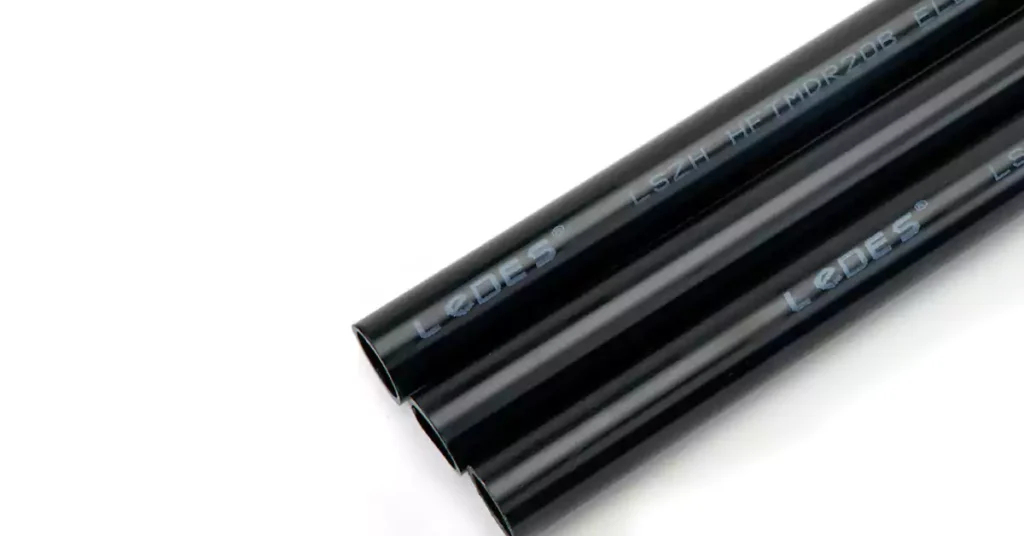
Both LSZH and PVC conduits must comply with specific marking requirements as defined by their respective standards. Markings ensure that the conduits are properly identified for compliance, installation suitability, and traceability. These markings generally include standard references, manufacturer information, size, type, and application-specific ratings.
Follow are some common marking requirements for them:
PVC 导管:
The phrase “rigid PVC conduit”
Schedule rating: Schedule 40 or 80
The complied standard
The trade size of the conduit product
The name or trademark of the manufacturer
The date or other dating period of manufacture
For Schedule 40 and 80 rigid PVC conduit that intended to used with 90 Degrees Celsius wires, should include “maximum 90°C wire” or “max 90°C”.
LSZH Conduit:
The phrase “LSZH or LSOH conduit”
The complied standard
The size of the conduit
The name or trademark of the manufacturer
Mechanical strength, such as “MD or HD”
Flammability rating: UL94 V-0 or 5VA
温度范围
The date of manufacture
When You Need LSZH Conduit?
Choosing the right conduit for an electrical system is crucial for safety, compliance, and long-term performance. LSZH (Low Smoke Zero Halogen) conduit is specifically designed for fire-sensitive environments where toxic smoke and halogen emissions could endanger lives and damage critical infrastructure.
Ideal Environments for LSZH Conduit
LSZH conduit is the preferred choice in areas where fire safety, low toxicity, and minimal smoke production are essential. These environments include:
- Rail & Metro Systems – Underground train tunnels, subway stations, and elevated railways require LSZH conduit to comply with NFPA 130 and international transit safety standards. Ledes LSZH conduit was successfully deployed in the Melbourne Metro Tunnel Project, where strict fire and smoke regulations were enforced to protect passengers and infrastructure.
- Airports & Aviation Facilities – Enclosed airport terminals, control towers, and baggage handling areas need LSZH conduit to minimize smoke and toxic gas exposure in the event of a fire.
- Underground Tunnels & Enclosed Spaces – Locations with limited ventilation, such as utility tunnels and mines, benefit from LSZH conduit since it reduces smoke density and allows for better evacuation visibility.
- Hospitals & Healthcare Facilities – In medical environments, toxic halogen gas from burning PVC conduit could pose serious health risks to patients and sensitive medical equipment. LSZH conduit ensures a safer alternative that meets strict fire and safety codes.
- Data Centers & IT Infrastructure – With the increasing reliance on cloud computing and critical digital infrastructure, data centers require fire-safe and non-corrosive conduit solutions. LSZH conduit prevents damage to expensive servers and network systems by reducing acidic gas emissions that could corrode electronic components.
- Electric Vehicle Charging Stations & Renewable Energy Projects – The growth of EV infrastructure and renewable energy demands safe, fire-resistant conduit systems. LSZH conduit is an excellent choice for EV charging hubs, solar farms, and wind power stations, where electrical safety and long-term reliability are key considerations.
When Safety & Regulatory Compliance Matter
Regulatory compliance plays a critical role in determining whether LSZH conduit is necessary. Many national and international standards specify LSZH conduit for fire-sensitive applications:
- NFPA 130 (Rail Transit Fire Safety Standard) – Requires the use of LSZH materials in enclosed railway systems.
- IEC 61386 (Conduit System Standards) – Defines LSZH performance requirements, including smoke density, halogen content, and fire resistance.
- EN 50267 (Toxicity & Corrosiveness Testing) – Ensures LSZH conduit meets low-emission and non-corrosive standards.
- UL 94 V-0 / 5VA (Flammability Rating) – Confirms superior fire resistance of LSZH conduit compared to traditional PVC.
In high-risk environments, the choice between LSZH and PVC conduit is clear: LSZH conduit provides superior fire safety, lower toxicity, and better protection for both people and equipment.
When You Need PVC Conduit?
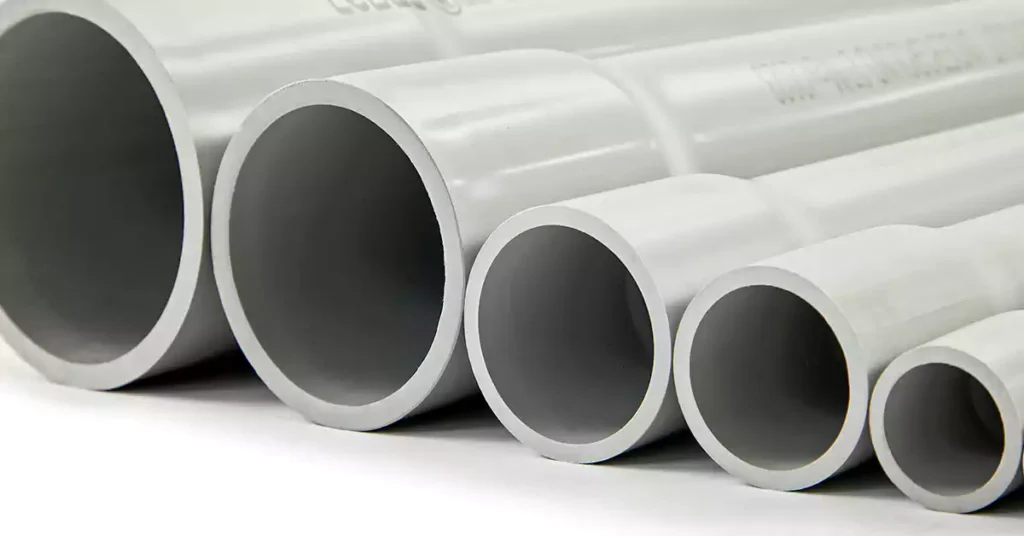
While LSZH conduit is ideal for high-risk environments, PVC conduit remains the most commonly used option for general electrical installations due to its affordability, versatility, and ease of installation. PVC conduit is the best choice when fire safety requirements are less stringent, and cost efficiency is a priority.
Ideal Applications for PVC Conduit
PVC conduit is widely used in standard industrial, commercial, and residential electrical systems where fire safety, toxicity, and smoke production are not primary concerns. These include:
Commercial & Residential Electrical Wiring – PVC conduit is commonly used for home wiring, office buildings, and retail spaces, providing an economical and easy-to-install solution. It is particularly effective in drywall installations, concrete embedding, and above-ground conduit runs.
Industrial Facilities & Warehouses – In manufacturing plants, warehouses, and large-scale storage units, PVC conduit is an excellent choice for general electrical protection in areas that do not require halogen-free materials.
Outdoor & Utility Installations – PVC conduit is suitable for outdoor electrical runs, solar installations, and telecommunications infrastructure, thanks to its UV-resistant and corrosion-resistant properties. However, in extreme high-heat environments, alternative materials like HDPE or LSZH may be preferred.
Underground & Direct Burial Applications – Rigid PVC conduit, including DB2, EB1, and Schedule 40/80, is a popular option for direct burial installations in commercial, residential, and industrial projects. It offers excellent resistance to moisture, soil chemicals, and mechanical damage when installed with proper fittings.
Cost-Sensitive Projects
PVC conduit is significantly more cost-effective than LSZH conduit, making it the preferred choice for projects that prioritize affordability over fire performance.
Lower Material & Installation Costs – Compared to LSZH conduit, PVC conduit is cheaper per unit and does not require specialized fittings or installation techniques.
Availability – PVC conduit is widely available, making it a practical choice for large-scale projects that require fast procurement.
However, in environments where fire safety, toxicity, and smoke production are critical concerns, LSZH conduit is the better option despite the higher cost.
How to Choose the Right Electrical Conduit
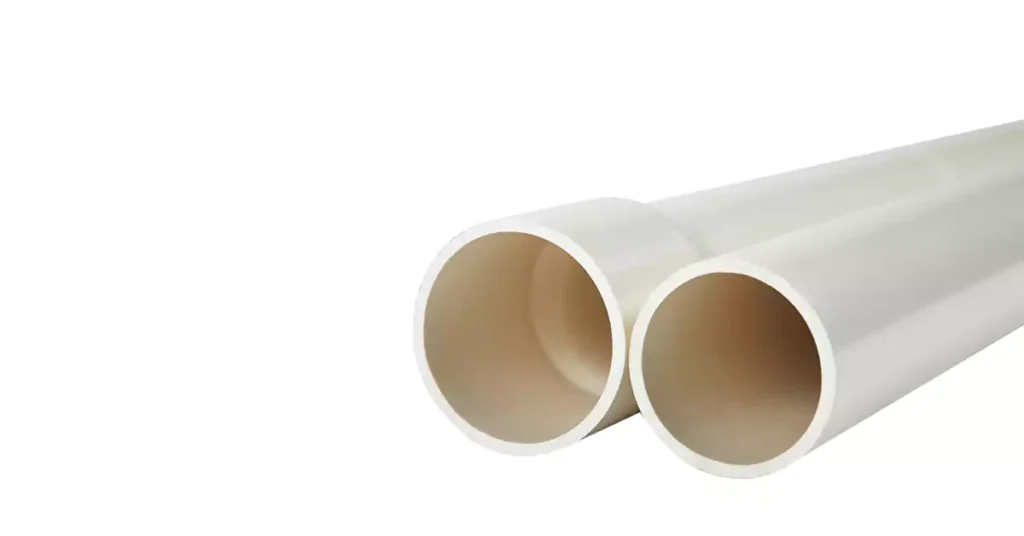
Selecting the appropriate conduit depends on several factors, including budget, safety requirements, installation environment, and regulatory compliance. Each project has unique demands, and understanding these considerations will help in making an informed choice between LSZH and PVC conduit.
Key Factors to Consider:
1. Fire Safety Requirements
If the project is in a high-risk environment where fire safety is a priority (e.g., tunnels, railways, data centers, or hospitals), LSZH conduit is the better choice due to its low smoke and halogen-free properties. PVC conduit may be sufficient for general applications where fire risk is minimal.
2. Budget Constraints
LSZH conduits generally cost more than PVC due to their specialized materials and fire-resistant properties. For cost-sensitive projects that do not require high fire safety compliance, PVC is often preferred.
3. Environmental Impact
LSZH is the more environmentally friendly option, as it does not release toxic halogens or corrosive gases during combustion. If sustainability and reduced emissions are priorities, LSZH is the better choice. However, PVC offers better recyclability in controlled conditions.
4. Installation Environment
Outdoor installations exposed to direct sunlight and varying temperatures require UV-resistant conduit. In enclosed spaces with limited ventilation, LSZH is recommended to reduce toxic emissions in case of a fire.
5. Mechanical and Structural Demands
For areas facing high stresses and forces, Schedule 80 PVC conduit may be more suitable. Heavy duty LSZH conduit, while offering high mechanical strength as well, but not as good as Schedule 80 under normal installation temperatures.
6. Regulatory and Compliance Needs
Ensure the conduit meets local codes and standards (e.g., UL, CSA, AS/NZS) based on regional and industry-specific requirements. Certain industries, such as transportation systems and hospitals, may mandate LSZH use.
By carefully assessing these factors, project planners and engineers can make the best decision on whether LSZH or PVC conduit is the most suitable option for their specific application.
结论
Choosing between LSZH conduit and PVC conduit ultimately comes down to understanding the specific needs of your project.
Throughout this article, we explored their key differences — from toxicity and fire safety, durability and lifespan, installation and maintenance considerations, to their environmental impact and compliance with various codes and standards.
In short:
- LSZH 导管 excel in environments where fire safety, low toxic emissions, and strict regulatory compliance are top priorities — such as subways, tunnels, hospitals, airports, and data centers.
- PVC 导管, on the other hand, are a great solution for standard industrial, commercial, and residential applications, offering cost-effective and easy-to-install options where fire risk is lower.
Final Recommendation:
Always align your conduit choice with your project’s safety requirements, environmental goals, budget constraints, and regulatory needs. Selecting the right type will not only ensure long-term performance but also significantly improve overall project safety.
Need help choosing the right conduit?
Feel free to contact us to request product catalogs, technical support, and competitive quotations.
We are happy to assist you with selecting the most suitable solutions for your specific project needs!
FAQs
What's the different between LSZH and PVC conduit?
To have a more clear understanding of the differences between LSZH and PVC conduit, here is the comparison table for reference:
LSZH Vs PVC Conduit Table
特征 | LSZH Conduit | PVC 导管 |
Smoke and Toxicity | Releases low smoke and non-halogenated gases during fire, safer for evacuation and rescue. | Can release toxic and corrosive gases (like hydrogen chloride) during combustion. |
Ideal Applications | Used in high-safety environments like airports, tunnels, hospitals, data centers, and railways. | Suitable for general industrial, commercial, and residential projects. |
Environmental Impact | Halogen-free, helps reduce environmental pollution. | Contains chlorine; incineration can produce dioxins. |
耐用性 | Strong impact resistance, compression strength, and wide temperature tolerance. | Excellent mechanical performance; needs UV protection and thermal expansion considerations outdoors. |
成本 | Generally higher cost due to material and performance advantages. | More affordable, ideal for cost-sensitive projects without strict fire safety needs. |
Standards Compliance | Meet strict standards of smoke, fire and other performance requirements, such as IEC 61386, IEC 60752, ASTM E662, UL 94, UL1685, NFPA 130 etc. | Certified under standards like UL651, CSA C22.2 No.211.2, IEC 61386, AS/NZS 2053 and other standards that required by local codes. |
Can LSZH and PVC Conduits Be Used Together?
Technically, yes — but it depends on the project requirements and safety standards.
- Fire Safety and Compliance:
In critical environments (like tunnels, airports, hospitals), mixing LSZH and PVC is usually not recommended. Many fire safety codes require the entire system — including conduits, fittings, and cables — to meet low-smoke, halogen-free standards. Using PVC alongside LSZH could compromise the overall fire performance and regulatory compliance. - Standard Industrial or Commercial Projects:
In less critical projects (like general commercial buildings or factories), using LSZH and PVC together is possible if the system does not have strict halogen-free requirements. For example, you might use LSZH conduit in sensitive areas (e.g., server rooms) and PVC elsewhere to save costs.
- Practical Considerations:
Connection compatibility: LSZH and PVC conduits typically use different formulations, but dimensions can be similar, especially when following standards like UL or CSA. Standard PVC fittings might physically fit LSZH conduits and vice versa, but check material compatibility if high mechanical strength or long-term sealing is important.
System Integrity: Mixing different material properties (thermal expansion, chemical resistance) could cause issues over time, especially in outdoor or extreme environments.
结论
If your project prioritizes fire safety, toxicity control, or must follow strict codes (e.g., NFPA 130 for transit tunnels), don’t mix LSZH with PVC — stick with full LSZH systems.
If your project has no halogen-free requirements and budget optimization is important, mixing may be acceptable — but it should be clearly documented and approved by the engineering team
Is LSZH always better than PVC?
Not always — it really depends on the project’s needs. Here’s a simple breakdown:
- Depends on the Application: LSZH conduit excels in environments where fire safety and low toxicity are critical, such as tunnels, hospitals, airports, and data centers. However, in open areas or projects without strict fire safety demands, PVC conduit is often a more practical and cost-effective choice.
- Fire and Smoke Performance: LSZH conduit produces far less smoke and no halogen gases when exposed to fire, making it safer for people and sensitive equipment during an emergency. PVC, on the other hand, can release dense smoke and corrosive gases when burning.
- 成本考虑: LSZH conduit is usually more expensive than standard PVC conduit. For projects with tight budgets and less critical fire safety needs, PVC can be the more economical option.
- Durability and Environmental Factors: Both materials are durable, but they have different strengths. For extreme temperatures, LSZH performs better than PVC. LSZH is especially chosen for its low-toxicity fire behavior and weathering performance, while PVC is often choose for installations where face high external forces, especially Schedule 80 rigid PVC conduit.
References:
IEC 61386-1: Conduit systems for cable management – Part 1: General requirements
UL Combustion (Fire) Tests for Plastics
UL 1685 – Smoke-Release Test for Cables and Conduit
IEEE Standard for Flame-Propagation Testing of Wire and Cable
NFPA 130: Standard for Fixed Guideway Transit and Passenger Rail Systems

